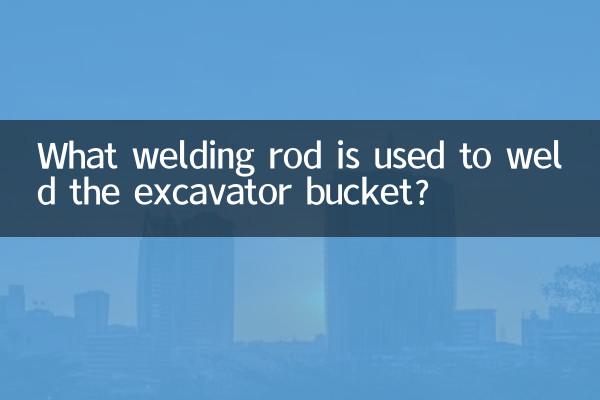What welding rod is used to weld the excavator bucket?
In the field of construction machinery maintenance and manufacturing, welding excavator buckets is a common and technically demanding job. Choosing the right welding rod is not only related to the welding quality, but also directly affects the service life and performance of the excavator bucket. This article will combine the hot topics and hot content on the Internet in the past 10 days to give you a detailed introduction to the types, characteristics and applicable scenarios of welding rods commonly used when welding excavator buckets, and provide structured data for reference.
1. Common electrode types for excavator bucket welding

The excavator bucket is usually made of high-strength wear-resistant steel, so you need to choose a matching welding rod when welding. Here are several commonly used electrode types and their characteristics:
| Welding rod type | Features | Applicable scenarios |
|---|---|---|
| J507(E7015) | Low hydrogen sodium type welding rod, good crack resistance and high welding strength | Suitable for welding high-strength steel, such as the stressed parts of excavator buckets |
| J506(E7016) | Low hydrogen potassium type welding rod, good welding processability, suitable for all position welding | Suitable for repair and general welding of excavator buckets |
| D256 (EDMn-A-16) | High manganese steel electrode with excellent wear resistance | Suitable for surfacing welding of worn parts of excavator buckets |
| D667 (EDCr-A-15) | High chromium cast iron welding rod, high temperature resistance and wear resistance | Suitable for extreme wear environments of excavator buckets |
2. Key factors in selecting welding rods
When selecting welding rods, the following factors need to be considered:
1.Material compatibility: The welding rod needs to match the base material of the excavator bucket. For example, high-strength steel usually uses J507 or J506 welding rod.
2.Welding position: For all-position welding (such as vertical welding, horizontal welding), welding rods with better processability should be selected, such as J506.
3.Wear resistance requirements: For severely worn parts, it is recommended to use wear-resistant electrodes, such as D256 or D667.
4.environmental conditions: In humid environments, low-hydrogen welding rods are required to reduce the risk of pores and cracks.
3. Hot topics on the entire network: Frequently Asked Questions about Excavator Bucket Welding
According to search data in the past 10 days, the following are the most popular issues in excavator bucket welding:
| Popular questions | solution |
|---|---|
| Cracks appear after welding | Use low hydrogen welding rod (such as J507), preheat the base material to 150-200℃, and control the interlayer temperature |
| Insufficient wear resistance of the surfacing layer | Switch to high manganese steel or high chromium cast iron welding rods (such as D256/D667) |
| Low welding efficiency | Use high-efficiency welding rods (such as J507FeV) or semi-automatic welding processes |
4. Welding process suggestions
1.Preheating treatment: For high-strength steel with a thickness exceeding 20mm, it is recommended to preheat to 150-250℃ to reduce welding stress.
2.Post weld insulation: After welding is completed, cover it with thermal insulation cotton to slow cooling to avoid embrittlement caused by rapid cooling.
3.Multi-layer welding: Multi-layer and multi-pass welding is used when welding thick plates, and the thickness of each layer does not exceed 4mm.
5. Summary
When welding an excavator bucket, the selection of welding rods must be comprehensively determined based on material characteristics, working conditions and welding position. J507 and J506 are suitable for conventional welding, while D256 and D667 are more suitable for wear-resistant surfacing welding. At the same time, paying attention to preheating, insulation and process control can significantly improve welding quality. The issues of cracks and wear resistance that have been hotly discussed on the Internet recently can be effectively solved through reasonable material selection and process optimization.

check the details

check the details